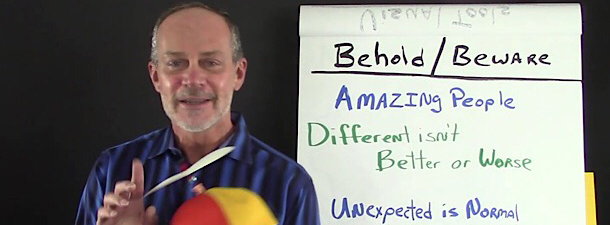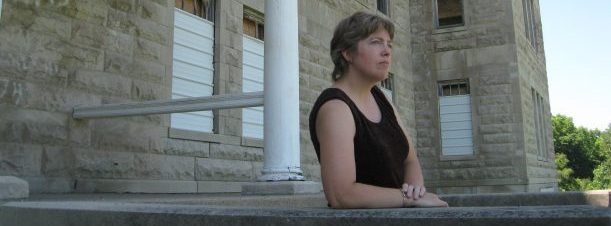Interview with Asperger’s Syndrome advocate Tim Goldstein

 Tim Goldstein is a professional who was diagnosed with Asperger’s Syndrome, a form of autism, when he was fifty-four years old. Tim describes himself as a “neurodiversity communications specialist” and he uses his skills to advocate for people with his condition by teaching major organizations and companies how workers on the autism spectrum think and function. Tim has subsequently created a design and implementation for a strategy that helps companies both recruit and support autistic workers. Tim calls his system the “Cloud Neurodiversity” idea.
Tim Goldstein is a professional who was diagnosed with Asperger’s Syndrome, a form of autism, when he was fifty-four years old. Tim describes himself as a “neurodiversity communications specialist” and he uses his skills to advocate for people with his condition by teaching major organizations and companies how workers on the autism spectrum think and function. Tim has subsequently created a design and implementation for a strategy that helps companies both recruit and support autistic workers. Tim calls his system the “Cloud Neurodiversity” idea.
Moreover, Tim has also published a book titled “Geeks Guide to Interviews: 15 Critical Items for the Technical Type”–to help high-functions autistic individuals cultivate their communication and social skills to help them get through interviews. He has also spoke at Microsoft’s DevDay conference in 2017 and teaches an online course called “Communicating with the Neurodiverse Tech Worker.”
In an exclusive recent interview, Tim discussed his experiences as a publisher, teacher, and Asperger’s Syndrome expert as well as his experiences of advocating for people with the condition.
Meagan Meehan (MM) of Entertainment Vine: When and how did you get interested in technology and what aspects of IT most appeal to you?
Tim Goldstein (TG): The technology bug bit me as a child. Tech in the late 60’s and 70’s was a very different animal than it is now with lots less computer and far more mechanical. I grew up on a farm and my dad was a master heavy equipment mechanic. That gave me lots of exposure to tech of the time and the chance to learn what we now call maker skills like, basic electronics, soldering, welding, and working with my hands. I was also fortunate to go to a very enriched public school system. All the boys were taught woodworking, printing, ceramics, metalworking, plastics, and electronics.
While I had the opportunity of being taught and surrounded by tech, it was never pushed on me. The interest was always there and I had encouraging parents. My first taste of computer technology was about 1975. I was in an advanced math program which had a shared mainframe and teletype! I completely fell in love with programming. At the time computers didn’t seem much of a career. I had an interest in computers, but no access to one.
I don’t have a single tech interest. I may focus on a specific technology area for a time or just long enough to solve a problem. Along the way, I learn about something so interesting that it may be a future direction.
MM: You were diagnosed with Aspergers Syndrome when you were in your fifties, so how did you find out about your condition?
TG: I want to set this up a little. While my story is pretty straight forward, the history of what we recognized as a condition and when we learned it has created some odd, but interesting results. It was about the early 90’s when we learned of Dr. Asperger’s work and we started gaining abilities to diagnose the conditions of autism and Asperger’s in the school setting. This has created what I call the thirty-year-old inflection point. If you are thirty or older you completed K-12 before the systems could identify the conditions. My Asperger’s traits were handled as disciplinary problems. I spent a lot of time in detention.
The thirty and over group doesn’t know, the majority have never been diagnosed. I think the most common way this group finds out is if they have a child with developmental conditions. This leaves most of the adult population struggling with the challenges of ASD, Autism Spectrum Disorder, but having no idea why. There are also what I call “A”SD Listers who may not meet all the criteria, but run similar brain software and struggle with the same challenges.
It was a few steps to my Asperger’s diagnosis. I burned out from a decade of two simultaneous full-time pursuits. First stop, the primary care physician’s office and antidepressants. Therapists, finally a psychiatrist. It wasn’t until he got my anxiety and depression issues controlled that Asperger’s became apparent. It is common to have condition like anxiety, ADHD, depression masking the ASD traits.
MM: Looking back, how do you think Aspergers affected your life and work while it was undiagnosed? Upon being diagnosed, how did things improve?
TG: Wow! How do I count the ways? I see two perspectives for how Asperger’s manifests in my life. The disease model is the most common. The afflicted person would be healed and restored to “normal” if the condition ASD were cured in them. This is like most diseases where the person has the condition, but the condition does not alter their Brain Operating System. While I can think of my anxiety and depression this way, it is not how ASD works for me. Asperger’s is the operating system my brain runs. Everything is perceived and processed through a mind which views and evaluates by logic and structure and just like Spock, emotion is not an item to be considered.
Back to the actual question. I do not believe there is an area of my life not impacted by Asperger’s. My mind runs the Asperger’s operating systems for brains instead of the neurotypical version. Every signal coming to my brain and every thought my mind considers is in a different context and language than it is for a neurotypical. I weigh risk/reward very differently which leads to different choices and prioritization. I am extremely comfortable alone which makes me pretty resistant to peer and social pressure. My mother recently said, “in school they pretty much let me do what I wanted as that was the easiest way to deal with me.”
Being diagnosed has been a huge help in our marriage. Karen is a saint for some of the adventures we have lived through. It is common for ND + NT relationships to not survive. I wish I could say being diagnosed solved everything, but what it did do was give me an area to research for understanding and communication. As we have learned more about how Tim’s Aspie OS mind functions, Karen and I have been able to build communication bridges. Accepting my diagnosis has led me to some unique ideas and concepts which are helping those on either side of the NT/ND transition. That is the most satisfying result.
MM: What inspired your books, how long did they take to write, and was it difficult to find a publisher?
 TG: There were two main inspirations. I have always enjoyed helping people learn new skills whether work related or not. The second one sounds weak even to me. My wife and I were training to create educational materials from our knowledge and experience. It was time for me to stop training and see if I could produce something useful. A book felt like about the right sized goal to take on. It was easy to choose interviewing for technical types for the topic as I had done very well in this area in my consulting career.
TG: There were two main inspirations. I have always enjoyed helping people learn new skills whether work related or not. The second one sounds weak even to me. My wife and I were training to create educational materials from our knowledge and experience. It was time for me to stop training and see if I could produce something useful. A book felt like about the right sized goal to take on. It was easy to choose interviewing for technical types for the topic as I had done very well in this area in my consulting career.
Start to end it took me about fifteen months to complete “Geeks Guide to Interviews: 15 Critical Items for the Technical Type.” The first phase was interviewing HR, hiring managers, and recruiters on what neurodiverse tech employees do to lose interviews they are technically qualified for. That took about three months. The next stage was synthesizing all the great input into themes and trends. With the help of a great research assistant, Ashani, this took about a month. I made good progress on writing the book, then stalled out for a number of months. Got back my motivation and it took about 6 weeks to wrap it up and lay it out for publication.
I self-published instead of going the publisher route. While there is a role for traditional publishers, in the age of Amazon I think self-publishing is becoming the main way for specialty topics. I like the complete control over the process it gives me and the ability to do special editions in small runs.
MM: What prompted you to start your mission to educate companies about workers with similar conditions?
TG: Prompted is not quite the right term. Captured is a better word. It started with the diagnosis of Asperger’s and beginning to learn the knowledge based training business. I would not talk openly about the diagnosis. As part of the speaking and story training I had to start telling insightful stories about myself. With Asperger’s being involved in everything I do, I put it in a presentation and told the story from my “A”SD Lister perspective. This was contrary to the coach’s teachings and lead to a highly charged discussion about Asperger’s with 25 participants tensely watching. As the coach and I came to an understanding, some of the other participants started asking questions about ASD. This was a very high-level group and their level of interest started nudging me.
The clincher was through another training experience. I was working with a well-regarded speech coach. He wanted me to change my approach to be more like the audience in the opening. I believe my biggest asset is my neurodiverse Asperger’s perspective and this change would undermine it. End result after half an hour, I could not communicate the thoughts and feelings in a way he could see my position. It was the first time I ever felt disable. After I got over the anger and frustration, I knew this was my calling. Working through companies is a multiplier to help reach the neurodiverse, especially those suffering from lack of awareness and support for their challenges.
MM: You use the term “neurodiversity” to describe the people you advocate for. Aside from Aspergers, what other conditions do people who find your courses useful have?
TG: I am going to refer to the Neuro Cloud picture to explain. While the concept of neurodiversity grew out of the autism community, its model is of perception and processing differences, not of autism. If you look at the picture the entire cloud represents all the ways people perceive and process. The largest group is called neurotypical NT. Not special or anything, just if an alien randomly grabbed someone they most likely would get a NT. Everything outside this NT group is neurodiverse ND. In the neurodiverse region you see grouping like ASD, ADD/ADHD, Dyslexia, OCD and you see lots of perception and processing patterns that have no name, just is not the NT pattern.
My materials are helpful for anyone. While I am primarily focused on the non-technical/technical communication barrier, my concepts and the ideas of neurodiversity apply to understanding and communicating with anyone who thinks differently. That can even be two neurotypicals dealing with each other!
MM: How did you go about setting up your classes and how do you teach people without these conditions to work alongside those that do?
TG: I work in numerous ways. The goal is to have a company engage me for a speech, training, or consulting as we need revenue to keep carrying this message. But I also speak and train through a variety of events, Microsoft Dev Day, SHRM Conference, Focused networking events, etc. Good old-fashioned deliver great content and value and keep doing it until the universe gives in.
Regarding teaching both sides of the coin, it is not as challenging as it may seem. My approach involves both sides accepting the other is different, then learning how to overcome the differences. In my concepts the foundational ideas are identical regardless of audience. Where it differs is in how the concept is implemented. In a mixed group there is value in each side seeing how the other has to approach it for true communication to happen. For more intensive work it does work better to address each group separately.
MM: How important is it for you personally to make things better in the workplace and is this need derived from personal history?
 TG: I think the best way to judge importance to someone is to look at what they have done to make that important thing happen. I have invested my future on this mission. I have a new voice, I got through all the baggage which held me back from talking about my diagnosis. I learned how to package concepts and explain ideas. I can now confidently talk about very personal subjects openly and authentically whether it is to one or hundreds. I think my actions say it is critically important.
TG: I think the best way to judge importance to someone is to look at what they have done to make that important thing happen. I have invested my future on this mission. I have a new voice, I got through all the baggage which held me back from talking about my diagnosis. I learned how to package concepts and explain ideas. I can now confidently talk about very personal subjects openly and authentically whether it is to one or hundreds. I think my actions say it is critically important.
The drive is definitely based on personal history. Even though I have had many successes, due to the lack of knowledge I have also struggled with many challenges both at work and home. Now that we have the knowledge, I don’t want to see other struggle as I have because of lack of easily understood information.
MM: What sorts of cool experiences has your career as a neurodiversity expert offered you?
TG: By far I count teaching a class at Cornell University as the coolest. Having an opportunity to help some of our future HR leaders to understand the unique perspectives the neurodiverse blows my mind when I think about the impact it can have over time. The other cool thing is the amazing people I get to meet. From global officers of international companies to wonderful neurodiverse individuals.
MM: Are you currently anticipating any exciting upcoming events and/or new programs?
TG: I am most excited about doing a training seminar for the Mile High chapter of SHRM, Society for Human Resource Management, January conference. These HR professionals will leave with new concepts and method that can help huge numbers of their employees. Two courses I am working on. There is the Understanding and Communicating with the Non-Technical for the Technical as the companion to my existing course. The other is Managing and Supporting the Neurodiverse for both managers taking on “A”SD Lister employees for the first time and managers in departments where my tribe is common.
I have a radio interview and a podcast interview lined up in the next few weeks. I am starting work on two courses: one on managing the neurodiverse and the other understanding and communicating with the non-technical for the technical.
MM: What do you wish more people knew about those with Aspergers?
TG: There are so many things it is hard to just list a few. The idea it isn’t Asperger’s or any specific medical condition per say, more my “A”SD Lister idea of anyone who has a brain operating system which works similar to the Asperger’s brain operating system. The concept the neurodiverse and the neurotypical effectively live in separate universes because of their different brain hardware and operating system. Effective interaction requires learning at least some about the others native universe and explicitly agreeing on the rules of engagement. This applies to all sides.
I wish people understood that we are nice people who want the same things as anyone else. To feel appreciated, to have friends, to have stimulating conversations, to care for their loved ones. But in our universe those things and more are thought about and acted on very differently.
* * * * *
To learn more about Tim, visit his official website, LinkedIn, and Facebook.


